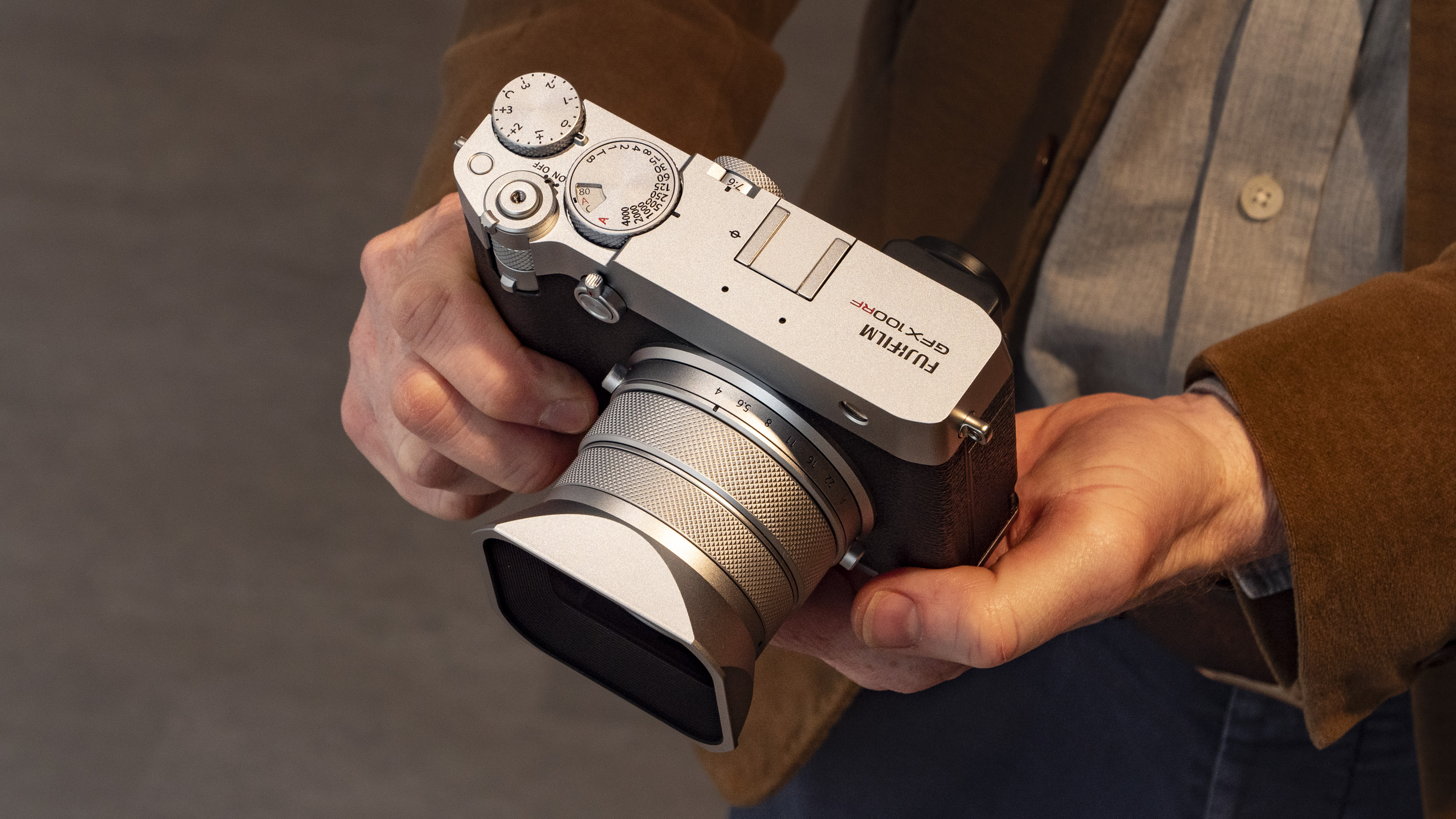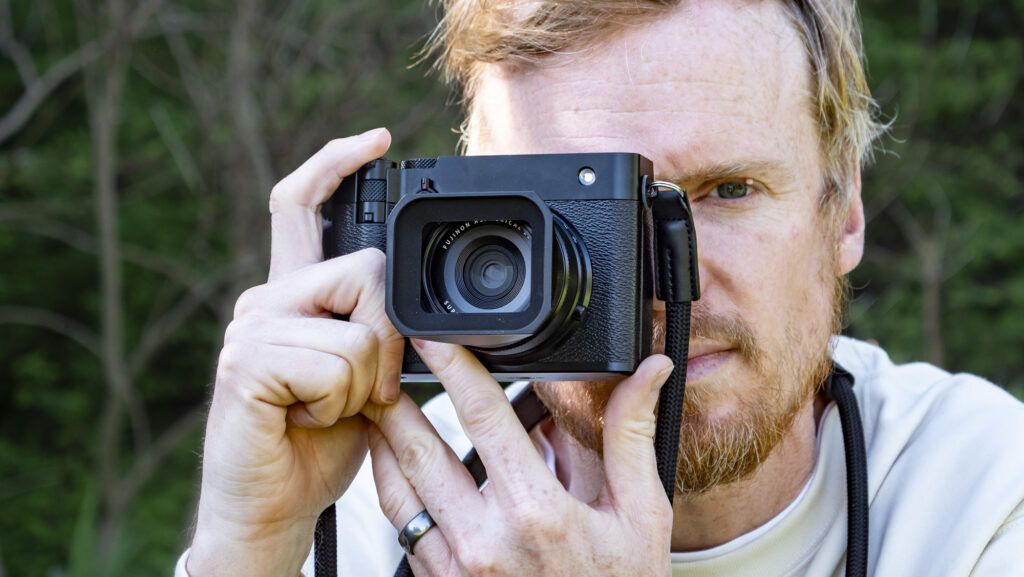Fujifilm has incorporated some distinctive design features, like a dedicated dial for aspect ratios, which may initially seem unusual, but they function very well and logically align with the camera’s technology. This can significantly influence your approach to composition.
The front switch on the X100VI camera, which allows users to toggle between the optical (OVF) and electronic viewfinder (EVF), instead lets you switch between different aspect ratios and digital teleconverter displays. This includes options for displaying your selected crop ratio as a frame line over the entire 4:3 image area, showing the greyed-out cropped area while still keeping it visible, or making the cropped area black so you only see the selected aspect ratio image.
Personally, I would have preferred the hybrid viewfinder found in the X100 series, but this model solely uses an EVF.
Many users of the X100VI exclusively utilize the EVF, but I favor the optical viewfinder, as it provides a bit of visibility beyond the frame, which is particularly useful for snapping street photography as subjects enter the shot.
Nonetheless, the 5.76 million-dot, 0.5-inch EVF performs excellently, and I genuinely value the aspect ratio and digital crop options. Additionally, the beautifully crafted 3.2-inch tilting touchscreen is seamlessly integrated into the body yet is easy to pull out, offering a bright and clear display – a quality that Leica could learn from.
Image 1 of 7
(Image credit: Tim Coleman)
Next, we encounter a set of stacked controls featuring a cropping lever, a command dial, and an on/off switch—this thoughtful design also includes the shutter speed/ISO dial.
A joystick simplifies navigating the menu and selecting autofocus. Each control is crafted for durability, while a raised bump on the front of the camera gives some grip, though it isn’t exactly what you’d call a highly grippy camera.
On the connectivity side, the left side of the camera (as you hold it) has ports for a mic input and headphone output, along with USB-C and micro HDMI. Meanwhile, the right side features two SD card slots. There’s…
The camera features a hotshoe at the top, allowing the attachment of accessories like an external flash.
All in all, the control layout for this camera is well thought out and user-friendly, avoiding an overload of features that might clutter its exterior. I found it easy to make quick adjustments, and throughout my testing phase, I didn’t encounter any significant issues.
Fujifilm GFX100RF: features and performance 6fps continuous shooting with autofocus, capable of up to 1,000 JPEGs Outstanding battery life of 820 shots Fujifilm’s top-tier autofocus capability Electronic stabilization for video, with no optical or in-body image stabilization It’s accurate to say that the Fujifilm GFX100RF emphasizes image quality over sheer speed, which is a common trade-off for high-resolution medium-format cameras.
Nonetheless, the GFX100RF stands out as one of the quicker medium-format options available, offering 6fps burst shooting that can handle up to 296 JPEGs or 40 RAW files—quite impressive considering the large file sizes. To optimize performance, it’s advisable to use a UHS-II V90 SD card.
Additionally, the camera is equipped with Fujifilm’s newest autofocus system, featuring subject-detection modes that identify people, various animals, and vehicles. Although Fujifilm’s autofocus isn’t yet on par with the speed and precision of Sony and Canon, it’s quite competitive, especially for a compact camera with a fixed wide-angle lens.
I was pleased to discover that, while framing portraits, the focus on the subject’s eyes was extremely sharp.
Image 1 of 3
(Image credit: Tim Coleman)
(Image credit: Tim Coleman)
(Image credit: Tim Coleman)
Initially, I was surprised when Fujifilm quoted a battery life of 820 shots for the GFX100RF; that’s typically 2 to 2.5 times what you might expect from similar cameras, making it seem unlikely.
To my delight, I learned that Fujifilm’s count was accurate. This impressive battery life can be attributed to the camera’s leaf shutter, which generally consumes less power than the shutters found in most other cameras—it’s designed to last throughout an entire day of shooting.
I’ve previously mentioned that the maximum f/4 aperture is, in my view, the primary drawback of the GFX100RF. The absence of optical stabilization is a close second. As a predominantly handheld shooter who prefers to avoid tripods, I find optical stabilization crucial for ensuring sharp image quality, especially with such high-resolution output.
There’s also a lack of in-body image stabilization (IBIS), which makes sense for a camera like this; however, the absence of optical stabilization is a significant downside for photographers. If you are interested in video, the camera does offer digital stabilization, which effectively minimizes camera shake.
Features and performance rating: 4/5 Fujifilm GFX100RF: image and video quality If high image quality and sharpness across the entire frame are your top priorities, then the Fujifilm GFX100RF is unmatched. Featuring a top-tier 102MP medium-format sensor paired with an incredibly sharp lens, I’ve closely examined various images and can confirm that the details remain impressively crisp from the image center to the edges.
My observations were made while directly comparing the GFX100RF to the Leica Q3, which is an even more expensive 61MP full-frame compact camera that previously set the standard for image excellence.
This exceptional quality makes the GFX100RF perfect for street and landscape photography, particularly with its 28mm full-frame equivalent focal length. Additionally, the 102MP sensor provides unparalleled cropping flexibility; even though its dedicated digital crop options of 36mm, 50mm, and 63mm don’t extend as far as the Leica Q3’s offerings of 35mm, 50mm, 75mm, and 90mm, each option delivers more pixels.
Image 1 of 6
This image uses the crop mode with an effective 50mm focal length, achieving the desired framing from the shooting location. The image size is still an impressive 35MP. (Image credit: Tim Coleman)
This showcases the complete 4:3 image area covered by the 102MP sensor. (Image credit: Tim Coleman)
Here’s a panoramic image in a 65:24 aspect ratio, which I believe fits this scene beautifully. (Image credit: Tim Coleman)
To conclude, I chose the Acros Film Simulation with a red filter – a black and white profile that enhances the depth of sunny skies. (Image credit: Tim Coleman)
The aspect ratio dial is a highly engaging feature. While you can achieve such effects in editing software, adjusting it in real-time enhances your creative workflow. (Image credit: Tim Coleman)
Returning to the classic 4:3 aspect ratio (Image credit: Tim Coleman)
I thoroughly enjoyed trying out various aspect ratios with the dedicated dial and became particularly fond of the 65:24 panorama setting, which made me see my surroundings in a new panoramic way.
Nevertheless, the GFX100RF may not suit everyone’s needs. For me, the maximum f/4 aperture of the lens poses a significant limitation. Additionally, it offers no image stabilization for photography, neither optically nor sensor-based, which restricts my ability to capture sharp images handheld, even with the less intrusive leaf shutter.
Moreover, I appreciate using a lens’s maximum aperture for creating a shallow depth of field, and in this respect, the Leica Q3’s 28mm f/1.7 lens is a superior choice, even though this lens is quite wide.
Within its intended uses, however, and combined with Fujifilm’s acclaimed Film Simulations color profiles, I’ve been able to produce images that are surprisingly high-quality for a compact camera.
Image 1 of 7
Fujifilm’s standard color profile presents a high-contrast appearance, but I prefer a more natural look. (Image credit: Tim Coleman)
While the maximum f/4 aperture is limiting, achieving a shallow depth of field is achievable if you’re close enough to the subject. (Image credit: Tim Coleman)
I managed to capture crisp details in this nighttime shot using a…
1/75 sec shutter speed and ISO 3200 sensitivity(Image credit: Tim Coleman)
The GFX100RF’s notable dynamic range captures details even in the sunlit area at the top left of the building. Many cameras would need to use an HDR mode to achieve this. (Image credit: Tim Coleman)
With a 28mm focal length, this lens excels in street photography. (Image credit: Tim Coleman)
I would prefer a shallower depth of field for this portrait, but unfortunately, that’s not achievable with the GFX100RF. (Image credit: Tim Coleman)
The image clarity is outstanding, sharp throughout the entire frame. (Image credit: Tim Coleman)
If I were to be picky about optical performance – having compared it directly with the remarkable Q3 – the GFX100RF does exhibit some lens flare when the sun is in view. In such scenarios, it’s crucial to use the included lens hood and to ensure that the lens and protective filter are free of dust.
Chromatic aberration is well managed, and while the bokeh is decent, the GFX100RF’s lens is not the best choice for achieving smooth, creamy backgrounds.
Image 1 of 3
In this shot, chromatic aberrations are virtually nonexistent – quite impressive. The bokeh quality is satisfactory. (Photo by: Tim Coleman)
The GFX100RF produces beautiful sunstars, but it can be slightly susceptible to lens flare. (Photo by: Tim Coleman)
While slightly underexposed, the tonal qualities are quite appealing. (Photo by: Tim Coleman)
The video specifications are solid but not earth-shattering. Fujifilm has prioritized perfecting 4K quality rather than impressing with 8K resolution. It offers 4K at 30fps using H.265 All-Intra 4:2:2 10-bit, and Full HD at 60fps, with bitrates reaching an impressive 720Mbps.
This high-bitrate usage means large file sizes, necessitating a top-tier UHS-II V90 SD card. You can also record 4K in the superior ProRes format with a 1,877Mbps bitrate and 60fps, albeit only to an external SSD.
This video quality is complemented by useful features, including a 4EV ND filter and digital-only image stabilization (applicable only for video) to minimize shake during handheld filming. While most users will primarily take photos with the GFX100RF, it can also create stunning 4K videos.
Image and video quality rating: 5/5
Fujifilm GFX100RF: testing scorecard Swipe to scroll horizontally
Fujifilm GFX100RF Attributes
Notes
Rating
Price
The bundle with camera and lens provides great value, though it remains a significant investment for anyone.
4/5
Design
Top-notch quality comes with thoughtfully selected design features, like an aspect ratio dial that makes perfect sense based on its internal technology.
5/5
Performance
The GFX100RF clearly focuses on delivering quality rather than speed, even though it performs quickly by medium-format standards.
4/5
Image and video quality
Outstanding detail from edge to edge, though limited by its maximum f/4 aperture. The video capability reaches up to 4K resolution.
5/5
Should I purchase the Fujifilm GFX100RF? You should buy it if… You should avoid it if… Consider these alternatives to the Fujifilm GFX100RF I believed that compact camera quality reached its peak with the 60.3MP Leica Q3; however, the 102MP Fujifilm GFX100RF raised the bar. Nonetheless, the Q3 has its advantages, particularly its stunning 28mm lens with an f/1.7 maximum aperture and its macro focus capabilities. Curious about how they stack up? I’ve analyzed both premium compacts in a direct comparison between the GFX100RF and Q3.
Read our detailed article on the Leica Q3
The GFX100RF might be excessive for the average user, making the more budget-friendly X100VI a smarter choice if you’re okay with waiting for back-orders. Both models feature a rangefinder-style design, but the X100VI provides a versatile hybrid viewfinder that toggles between optical and electronic modes, unlike the GFX100RF which only has an EVF. Its 40MP APS-C sensor and 35mm f/2 lens deliver impressive results, and many might not notice a quality gap between the two, especially considering the X100VI costs a fraction of the price. However, when it comes to image quality, nothing surpasses the GFX100RF.
Read our detailed article on the Fujifilm X100VI
My testing process for the Fujifilm GFX100RF (Image credit: Tim Coleman) I attended a pre-launch session and had hands-on experience with the camera Fujifilm later provided the camera for a 10-day evaluation I extensively utilized the camera, comparing it directly with the Leica Q3 My experience with the GFX100RF was shorter than I wished, but sufficient to gain a solid understanding of the camera and its features.
Delving into its standout features, such as the remarkable 102MP sensor, digital crop options, aspect ratio settings, and color profiles led to separate articles, along with my comparison with the Leica Q3, another premium fixed-lens compact.
I also tested the camera’s performance, focusing on burst shooting and video functionality, and scrutinized the lens quality, examining edge-to-edge sharpness and bokeh.
Reviewed for the first time in April 2025




